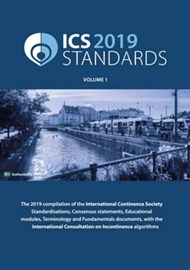The highly anticipated fully updated 2019 edition of the International Continence Society (ICS) Standards is a comprehensive ‘book’ that compiles peer-reviewed documents into one easily accessible area of 935 pages.
It has taken the joint effort and expertise of over 200 well-renowned and highly respected healthcare multidisciplinary professionals to put together a book of such volume. Top researchers and clinicians in their respective fields of urology, gynaecology, urogynaecology, gastroenterology, physiotherapy and many other areas of medicine shared their time and knowledge and made it possible to publish this comprehensive and vital document.
It is structured in six main sections:
- The ICS Standardisations sets a reference point for terminology and good practice on scientific and clinical grounds. Strict adherence to correctly used terms ensures unification in the practice across the world, not only through description of one’s symptoms and signs, but also their sophisticated interpretation and clinical judgement.
- The Fundamentals set out the range of knowledge that is aimed for any clinician who assesses lower urinary tract dysfunction in their everyday practice. It covers urinary symptoms both in general and specific patient groups such as nocturia, chronic pelvic pain and neurological disease patients. It is deliberately designed to provide relevant scientific and clinical information not only for specialists and their trainees but also other people working in related disciples like neurology and primary care.
- The ICS Standards’ third chapter derived by the International Consultation on Incontinence (ICI) expert committees outlines the evidence-based therapy pathway for both initial and specialist assessment and care. It offers the readers a clear and easy to follow step-by-step approach to all major relevant clinical scenarios and it manages to do so with a convenient coloured graphical design.
- The Consensus documents found in the fourth section provide a concise summary of the published literature and the state-of-the-art knowledge on a particular topic. The periodical re-evaluation of all the evidence in order to keep up to date makes this chapter especially valuable. I can only presume that among others, the ICS consensus on the diagnosis and treatment of nocturnal polyuria and ICS Best Practice Statement for Use of Sacral Neuromodulation will be greatly appreciated by both junior and senior academics and clinicians.
- The ICS Education modules in the fifth section are invaluable covering practical aspects in various urodynamic techniques.
- The final section is the ICS glossary which covers all the standardised terms defined and used internationally in the field.
Overall, the latest ICS Standards compilation is an evidence packed book that comes at a reasonable price and is virtually a must have for anyone involved or interested in the field of functional urology, urogynaecology and other associated disciplines. It is also available free as an eBook to ICS members.





